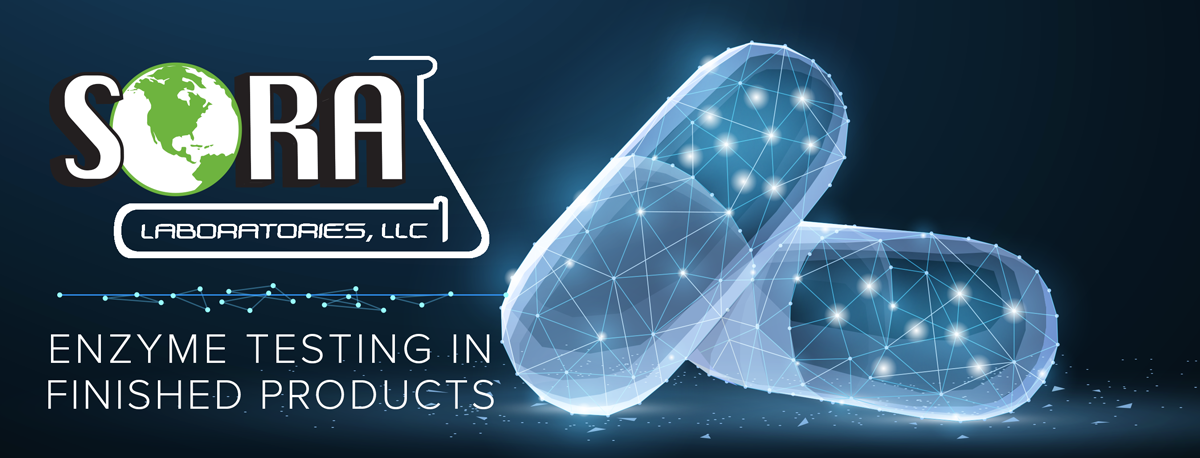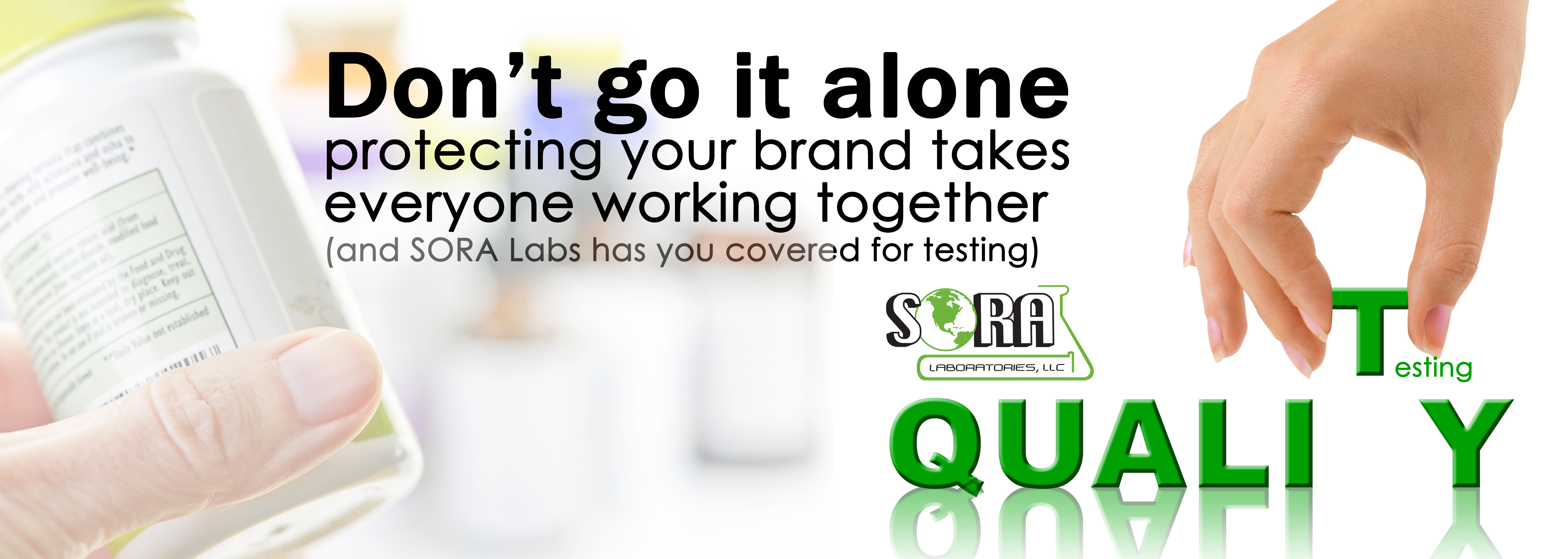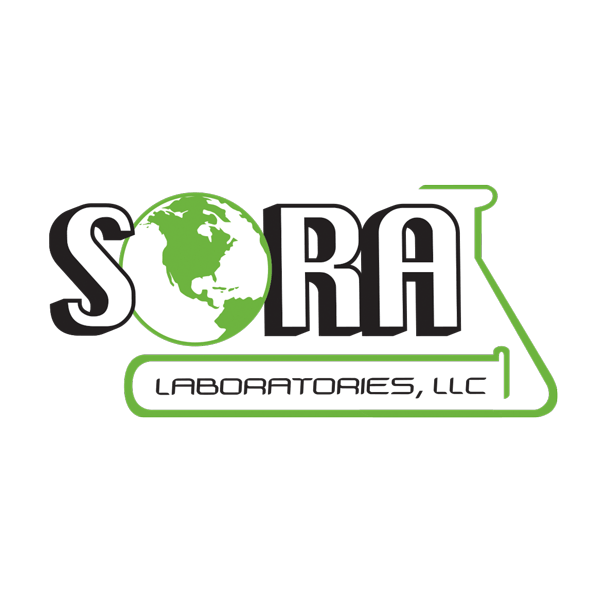SORA Labs has been testing enzyme activity assays and probiotic enumeration for more than 30 years. In fact, we were the first lab to add enzyme activity assays to an ISO/ICE 17025:2015 scope of accreditation in the U.S. Most of the methods we use come from the USP/FCC, BP, JP and other compendia, which are designed for raw material testing. One question we hear frequently is if it’s possible to test enzyme activities in finished products containing an enzyme blend. The answer is YES! We can test enzymes in finished products, however, like most analyses, it’s not as straight forward as raw material testing. Based on these experiences, we have put together a list of common interferences seen with finished product enzyme testing.
1) Combined Protease Effect: This occurs when several proteases are mixed together in a single blend. The protease activity of each enzyme is magnified by synergistic effects and boosts the protease activity. Enzymes are standardized to a single activity but may have other non-standardized activities present. These non-standardized activities are called side activities and can cause the proteases to show higher than expected results.
2)Enzyme/Carbohydrate Interference: The most common observation of this phenomena is with lactase but can be seen with other enzymes also. Lactase results often fall below label claims because of carbohydrates in the blend.
3) pH Co-Ingredient Interference: Enzyme activity assays are pH and temperature- controlled reactions. When the assay conditions are altered, the reaction may be affected, and the method may not perform correctly. Ingredients like betaine HCl, lemongrass, calcium carbonate, ox bile, and other high or low pH ingredients may swing the pH of the reaction solution outside the ideal method pH. Sometimes adjustments can be made to allow the reaction to run, but this is not always the case.
4) UV Co-Ingredient Interference: Many enzyme activity assays have a UV-Vis endpoint. If botanicals or other chemical ingredients are included in the enzyme matrix finished product, these ingredients may cause UV interferences. Methods that look for a change in UV absorbance could show inaccurate readings if these co-ingredients have similar UV characteristics.
Providing as much information about your product before testing begins will help determine possible interfering ingredients. When a testing lab is an extension of your team, you have a tremendous asset, because all these interference scenarios can be proven with testing.
We often use small sized, formulation-specific, lab blends, which allow us to remove the interfering ingredient(s) and then test the activity again. If the recovery is improved and the results meet label claims, then the product interference is confirmed.
We can also perform spike studies and measure the recovery of a known enzyme spike. Adding a known amount of enzyme into the finished blend and then testing for activity, will help determine the interference. When only partial recovery of the spike is observed, then this shows that there is interference with the testing.
Getting the blend testing and interferences figured out at the product development stage is very important to preventing product delays later in the process. Once products are ready to be shipped, then it is often a stressful scramble to understand why label claims are not being met. SORA Labs is here to help! Let us test your products so you can understand any interferences that are present. Remember, understanding your product’s unique characteristics early on, will help set the stage for successful manufacturing and sales.
You can’t go it alone—protecting your brand takes everyone working together!
The quality of the products under your brand is one of the most critical aspects of business success and vendor/supplier qualification is one of the most important steps in that process. In fact, this step is required in the Code of Federal Regulations (CFR) 111.75. Furthermore, to avoid warning letters, build confidence and maintain a positive reputation in the marketplace, safe and tested ingredients are a must.
CFR 111.75 outlines a very detailed process to follow. One of the first steps in establishing the reliability of the supplier’s certificate of analysis (CoA) is through confirmation of the supplier’s test results or examinations. This can be accomplished by setting the specifications and then testing using one or more methods for identity, purity, strength and composition of the component or ingredient. Also required by CFR 111.75 (c)(1), is testing for limits of contamination that would lead to adulteration of the finished product. This testing verifies that the vendor shows identity and acceptable levels of active ingredient markers. It also ensures that there is no microbial contamination, heavy metals, pesticide residue or other harmful contaminates.
Another key to supplier qualification is the supplier audit, which provides valuable information about the quality management system of the supplier. It also shows how the material is tested and how the vendor will ensure specification compliance from batch to batch, along with many other aspects of the company’s processes. By combining testing with supplier audits, a brand can consistently monitor the supplier and build confidence in its ability to produce high-quality ingredients. Once the supplier has been qualified, then reduced testing might be an option.
One FDA response letter (Addressed to Heron Botanicals Inc. on May 25, 2015) prompted the company to defend its position that it makes no claims to the amount of “active ingredients” in its finished product. As such, the company argued that testing was not needed for the “active ingredients” in the raw material. The FDA disagreed with this response because the company lists a 70 percent extract material on its label. Without testing the raw material, the company was unable to prove it started out with a 70 percent extract.
If this company had established a supplier qualification and showed testing results for the raw material over several lots to prove it met label claims repeatedly, then it may have been able to justify not testing the raw material “active ingredient” for this product. In this instance, the documented supplier qualification may have been all that was needed to avoid a warning letter.
Vendor qualification, although an often under-utilized process, is really the key to safe and high-quality ingredients. By testing raw materials and qualifying suppliers, this will strengthen the quality of your products and help protect your brand. Ultimately, It takes everyone working together to ensure the quality of the supply chain—and that definitely should be the main goal of any manufacturer. Are you doing your part to avoid FDA warning letters and produce quality products by working with a quality, certified and accredited testing lab? If not, SORA Labs can be your partner in quality!
Probiotic testing challenges—the right lab makes all the difference!
Probiotic testing can be complicated. Here’s why—most of the testing methods available are for single strain raw materials. Additionally, many methods come from the manufacturer and are specific to their material. And if that didn’t create enough confusion about what testing was appropriate, the Food Chemical Codex (FCC) has also added several probiotic monographs. These monographs have procedures for identification, enumeration assays and specific Whew! So how can you decide which testing method to use—the answer lies within using a lab that is experienced in probiotics.
An experienced lab like SORA, will know that the identification portion of the FCC monograph is for nucleic acid-based identification using PCR or other genetic identification methods. The assay portion of the monograph uses various growth media and specific aerobic or anaerobic conditions for optimal growth of the probiotic strain. The specific test section will have testing recommendations for that particular strain of probiotic.
Since these procedures require specialized equipment, and specific agars and broths to perform the testing, this can be challenging due to the high growth counts of this material. Typically in a microbiology lab, the samples being tested have very low plate counts, but with probiotic material, high counts in the millions or even billions of cfu/g are expected. Lab contamination is also a concern when working with probiotics, so proper sample handling is very important to ensure that the testing environment and air quality stays clean. Because of these challenges, working with probiotics in a separate section of the lab and at separate plating times is often required to avoid microbiology contamination of other samples in the testing lab.
While finding the best assay method may be difficult when working with blended probiotic strain products, reviewing the individual strain methods and looking for overlapping testing is generally a good starting point. And, since there may not be one “ideal” method, the testing lab may need to attempt several probiotic methods and perform method development before exact testing can be determined for the specific product.
With so many challenges, it may seem daunting to make sure your product is being properly tested! However, choosing a lab that is accustomed to handling probiotic material and performing specialized testing such as SORA Labs, can take the stress out of making sure your product meets label claims—choose wisely.



